As if we hadn’t been busy enough the weekend before last and the one before that, there’s more that I’m only just getting around to blogging!
It was only when I thought about writing this up that I realised how much I’d neglected to write about already (and had promised people would be “coming soon”). So, without further ado;
here’s what Ruth, JTA and I got up
to last weekend.
Aside from our two attempts to conquer the Dunwich Horror (both attempts were failures, although the second was ever so close, ending
with Ruth’s character in a one-on-one deathmatch with a Great Old One), our major event was a trip down to London on Saturday. After all, since the move to Earth, London feels like it’s pretty-much on our doorstep: so there’s no excuse not to take in a
bit of culture once in a while in the heart of the capital. Of course, when we say culture…
Ye Old Cock Tavern
We started out in
Ye Old Cock Tavern on Fleet Street, because – hey – early afternoon is a perfectly good time to start drinking on a weekend. They did some pretty good chips, too, which we picked at
as we drank our pints and watched a crowd gather for a wedding at the church up the road, nestled between the old newspaper buildings.

Volupté
Next up was Volupté, a burlesque club with a bi-monthly lunchtime Afternoon Tease. We started with a few fabulously-mixed and ludicrously ornate cocktails: only the first of many. The
bar staff are simply entertaining to watch
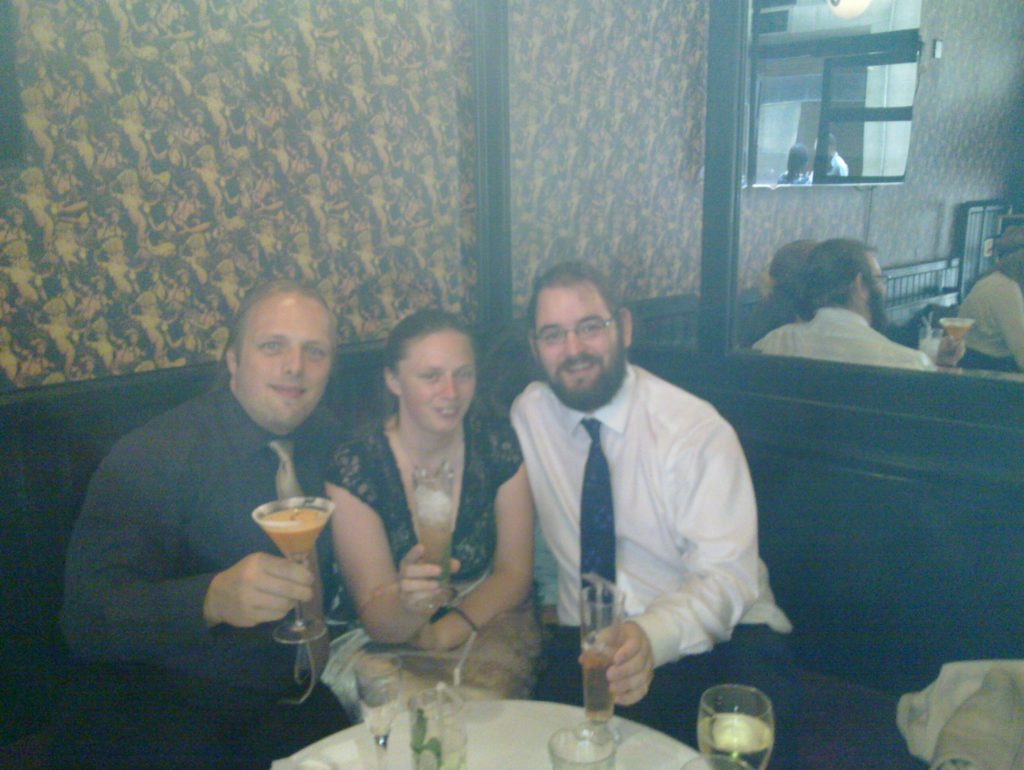
Aside from the ongoing stream of cocktails (I particularly enjoyed the Porn Star Martini – which I’m seen drinking in the picture above – I don’t even remember what was in it, except
that it came with a “shot” of champagne to drink before starting it), Afternoon Tease consisted of:

- Drinking champagne and eating finger sandwiches
-
A guy dressed as Elvis, spinning hula hoops in ways that I didn’t think possible, to a medley of Elvis hits.
- An extraordinarily erotic, genuinely tantalising peacock dance from a young lady going by Vicky Butterfly. She later returned for a second, different performance; not
quite so arousing but equally mesmerising. That’s her in the picture, above.
- Volupté’s special take on traditional tableaux vivants
– gateaux vivants: a wonderfully mischievous woman posing behind little more than suspenders and a cake (with a fabulous parody of M&S food adverts gone by).
- Scones and tea
- A Miss. Rose Thorne, performing a tribute to Doris Day; and I can honestly say that I’ve never before seen a pair of gloves removed with such… deliberate choreography.
Very impressive.

By the time we staggered out into the afternoon sun, we were very entertained and quite spiffingly drunk. Volupté gains my recommendation, although I shall have to check the state of my
bank account before trifling with their cocktail bar again!
The Golden Hinde
Next up, we made our way over the Thames to visit the replica of the Golden
Hinde, the ship in which Sir Francis Drake completed his famous circumnavigation of the globe.
 Yeah, it’s just a big boat (and not even
that big). Ruth was pleased, though, but she is almost a big a fan of boats as she is for optimised road junctions. Of course, not to break the theme, we stopped for a drink in
each of the two nearest bars to the vessel, as well as a snack to give us the energy for the next leg of our adventure, when we whipped out our Oyster cards and zipped down to Hammersmith for…
Yeah, it’s just a big boat (and not even
that big). Ruth was pleased, though, but she is almost a big a fan of boats as she is for optimised road junctions. Of course, not to break the theme, we stopped for a drink in
each of the two nearest bars to the vessel, as well as a snack to give us the energy for the next leg of our adventure, when we whipped out our Oyster cards and zipped down to Hammersmith for…
Penn & Teller
Yes, the Penn & Teller, during their 4-day-only visit to the UK (the first in 15
years), doing their usual mixture of magic and comedy in their in-your-face style, in a spectacular London show. If you’ve gotten this far down the post before you realised how awesome
my weekend was, well, what took you so long?
I couldn’t even pick out my favourite part of the show. Perhaps it was one of these:
- Teller “drowning” at the end of the first act as part of a card trick (yes, really!) gone wrong.
- A whole series of fabulous tricks done with evidently-confused members of the audience (especially the one with the woman they had blindfolded and throwing knives towards Penn, and
narrowly missing – it was all done with electromagnets, see?).
- Stunning examples of cold-reading done using jokes randomly selected from joke books, with a predictive “hot reading” twist at the end.
- The thought-provoking ending, in which Penn (between bouts of fire-eating) asks the audience to think not about how they do what they do, but why, along with some clues related to
his experiences as an audience member of various shows.
 Sundeep!
Sundeep!
By remarkable coincidence, Sundeep and her partner, Ashley, were also at the Apollo to see Penn & Teller! Wandering back from the bar during the intermission we just bumped into her. As
she doesn’t blog these days, for the benefit of those who might be wondering: she’s doing well, still on maternity leave and looking after Vanessa, her daughter (who’s looking quite
cute in many of the billion or so pictures she carries around with her on her phone), and both are happy and healthy. Ashley – whom we hadn’t met before now – seems nice: he has a
certain rugged-but-cute French look and he works for a very worthwhile charity, both of which give him good points in my estimation.
Mexican Tapas
After leaving the show, we were peckish again, so we went around the corner to a cramped but wonderful-smelling Mexican restaurant for a round of Mexican-style tapas, which was
delicious. By this point, we were just about ready to settle into a bus for the long but comfortable journey home, when…
Penn & Teller, Again
…wandering back, we spotted a small crowd of people near the Apollo. Wandering over, we discovered that Penn & Teller themselves were hanging out with folks outside the theatre, signing
things and answering awkward questions.
Needless to say, we hung around for a few minutes and got the chance to meet the magicians themselves.
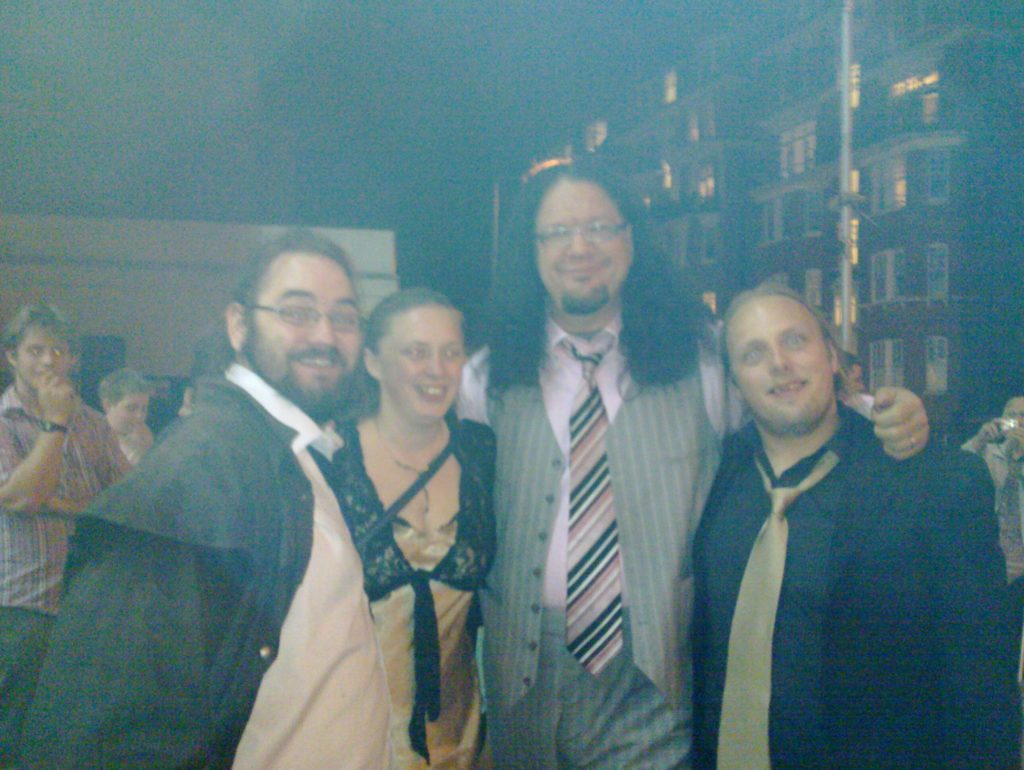
Ruth – perhaps as evidenced by her expression in the photo, above – did her usual thing when in the company of a celebrity (as those of you who knew how she behaved around Lloyd Kaufman will
know) of becoming a giggling little girl. She also managed to make a fool of herself by mumbling a question about the stage lighting to Teller, to which he didn’t have an answer (not a
result of his on-stage muteness, though: he’s certainly happy to talk in person).
Meeting some of the most fabulous (and eccentric) magicians in the world is perhaps the best way to end a night out in London. But there was one more stop on our journey as we worked
our way back to a Oxford Tube
stop (avoiding the Circle Line, which wasn’t running):
White City
Yeah; perhaps not actually the highlight of the night, but as we were passing, Ruth insisted that we should get one more photo – for Adam‘s sake:
 In case your eyes
aren’t up to it, or if you’re simply unable to recognise this iconic London landmark, that’s the White City BBC Television Centre in the photo.
In case your eyes
aren’t up to it, or if you’re simply unable to recognise this iconic London landmark, that’s the White City BBC Television Centre in the photo.
We got back to Oxford a full 15 hours after we’d first left: considerably more exhausted, more drunk, and merrily surfing the buzz of all the fabulous things we’d gotten up to over the
course of the day. Sunday became very much a day of rest (and recovery) – we’re not as young as we used to be, as I discovered to my horror during my last party-sized jaunt into the capital. Exhaustion aside, however, this was a
fantastic day out.
How’ve your weekends been? Not as legendary as mine, I’m sure.




